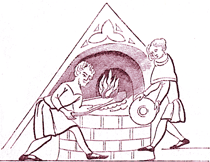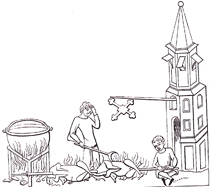Medieval Cooking
Medieval cooking played an important role in the progress of culinary art, that complicated science created over the centuries. We are going to have a look at the epicurean customs of the Middle Ages, especially in France. Medieval cooking was not such a different affair when compared with the methods used in contemporary kitchens. It was subordinated to the same continuous desire of the human being to provide food not for his support only, but also for the pleasure of the taste.
So, what were they eating, what were they cooking?
Medieval Soups
The poems of the 12th and 13th century mention soups made of peas, of bacon, of vegetables, and of groats. In the southern provinces soups were made of almonds, and of olive oil. Other varieties of soup were made of water-cress, cabbage, cheese, and the gramose variety, which was prepared by adding stewed meat to the water in which meat had been previously boiled, and adding beaten eggs and verjuice.
A number of dishes were named soups, although their cooking was more sophisticated. The haricot mutton was actually closer to a stew, while the chicken or veal broth with herbs were much thinner. The soups could be made also of veal, pork, stag, oe even wild boar. The hare and rabbit soup were flavored with green peas. In the 1300s, the broths were made with millet-flour and mixed wheats.
The Middle Ages methods of cooking used pure wheat flour soaked in milk, to which butter and yolks of eggs were added. The mixture was seasoned with sugar, honey, and aromatic herbs. The chefs were known to use also saffron, and even sweet wine. This resulted in the Medieval bread being closer to what we name today a cake, and the recipes used to make it laid the foundation for the future art of pastry cooking.

Baking the Bread
Medieval Pies, Stews, Roasts, Salads
Contrary to a common belief, pastry cooking was already known in the Middle Ages. The pies were highly appreciated, and were cooked using a large variety of white and red meats or fish. In the first category, chicken, geese, or pigeons were very popular. Red meat pies were made of venison, veal, rabbits, or beef, a common recipe using minced meat and raisins. Fish pies were made with whatever was available in the vicinity. Known recipes were using salmon, or a mixture of chopped fish and cod liver.

Cooking Outdoors
The stews were made of veal, beef, lamb, bacon and lots of vegetables. A well-known specialty was, and still is, the tasty French chicken stew called fricassée. It was flavoured with many spices, and sprinkled with verjuice. When served, it was surrounded by the so-called "green sauce" made of vinegar, breadcrumbs, cinnamon, and ginger.
The roasts were as popular as ever. The sirloin of beef was more common, while the rich could afford such extravagances as the swan and the peacock. Cooking the roasts was a bit different in the Medieval times. To make it tender, the strong meat was boiled before roasting. The roast was first basted with orange juice and rose-water, and covered with sugar and powdered spices. We should also mention the broiled dishes, the invention of which is attributed to hunters, and referred to by Rabelais as irresistibly exciting the thirst for wine.
The Middle Ages salads contained, besides the herbs, cooked vegetables, together with chicken liver, crests, or brains. In the 1400s it was already customary to serve the salads after roasts, and then fish, either fried or sliced with eggs. For dinner, the salads were served accompanied by eggs cooked in various ways: poached, hard-boiled, or like a sauce.
Medieval Seasonings
Cooking the Medieval way required heavy use of spices, the choices being greatly diversified beginning with the Crusades. While salt was the basic condiment on anybody's table, pepper and other spices were now imported from the East. Cinnamon, cloves, ginger, nutmegs, mace, and caraways are mentioned in cookery books of the period. In France, Dijon and Angers became famous for their mustard, which was cultivated and manufactured in the neighborhood. Garlic was intensively used in cooking, and also as a medicine, especially by peasants. In towns, people enjoyed a garlic sauce named aillée. In Paris, due to high demand, it was ready prepared on a large scale, and sold in the streets.
Anchovies were also used as a flavoring. Generally, the basis of any sauce was the verjuice, used together with wine vinegar. The verjuice was originally the juice of sorrel. The famous balsamic vinegar of Modena is mentioned in documents dating back to the 11th century. All non-piquant sauces were made with perfumed water and sugar.

Carrying Up The Dinner
From The Kitchen
Due to the high number of spices available on the English market, the royal establishments had a special office, named the "spicery", which was superintended by an officer whose duty was to decide upon the proper spice quantities to be used by the chefs.
Medieval Sweet Dishes, Desserts
Sophisticated desserts were other highly appreciated results of Medieval cooking. In the 1300s, a multitude of fruits were served for dessert: baked pears, walnuts, figs, dates, grapes, peaches, filberts, and white or red sugar plums. What we call sweet dishes were initially served only at feasts, having the main purpose of proving the imagination and the talent of the master chef.
The sweet dishes could be dry or made with cream. The former consisted of dry and sweet pastries made of almonds and nuts. The later included the cheesecake and the wafers, which the Medieval chefs were cooking even before the 13th century.